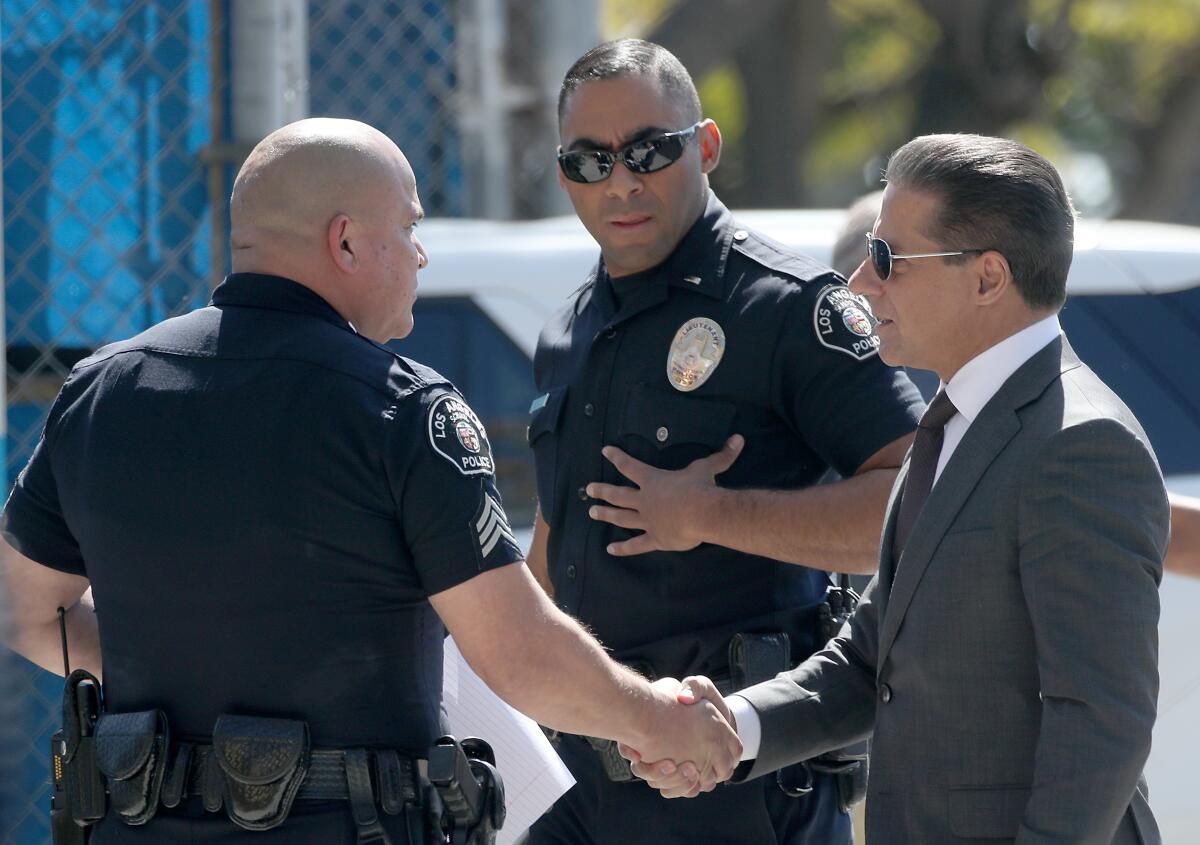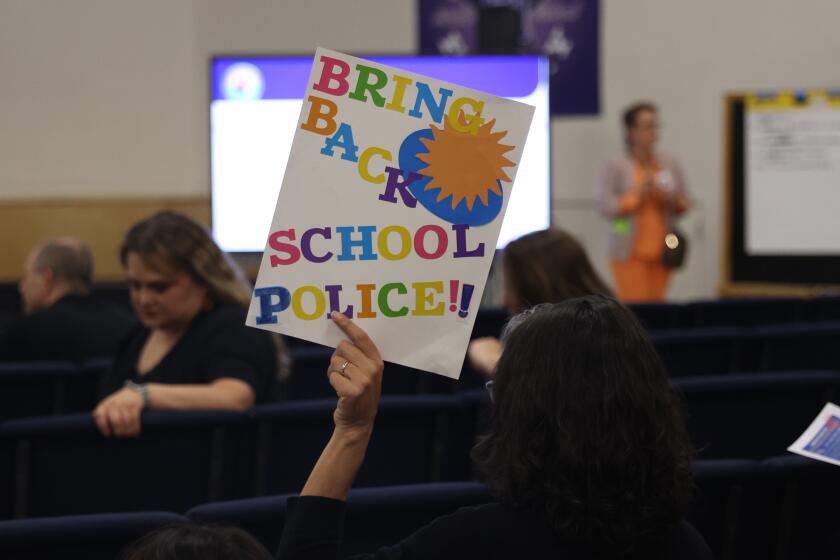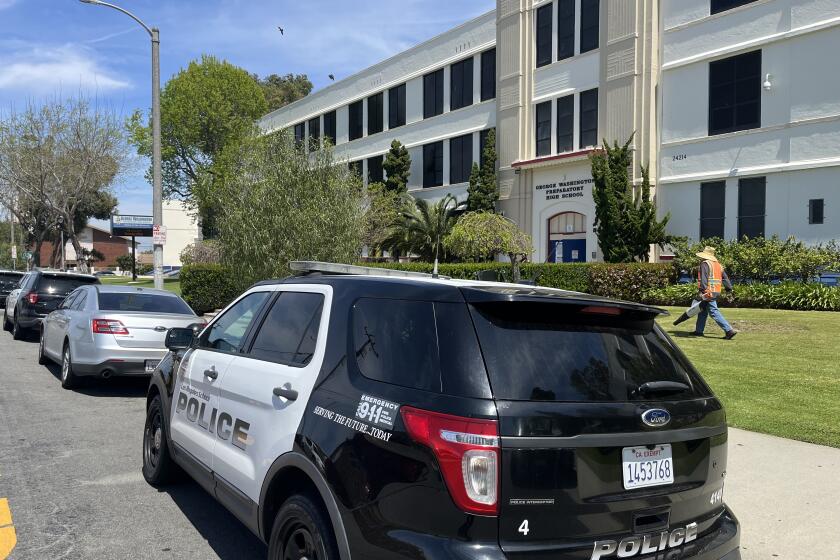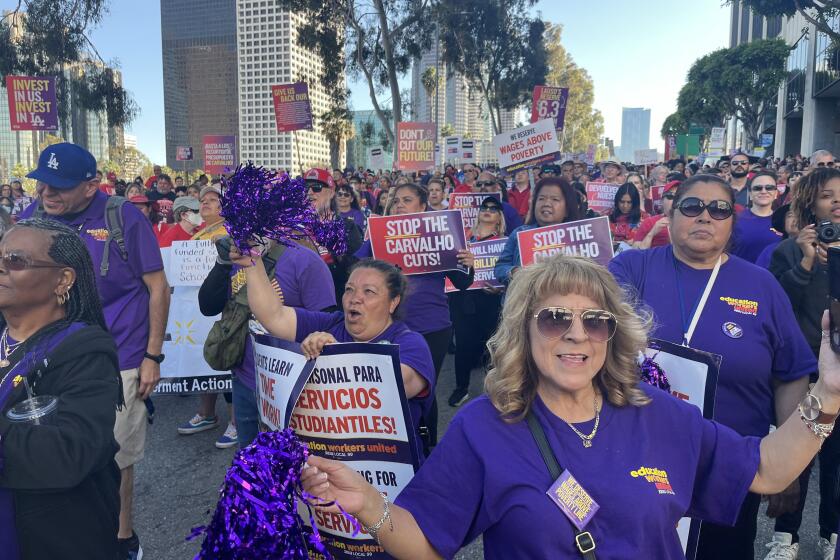LAUSD police deployment to 20 schools collapses after one day amid opposition, confusion

A plan to return police to 20 troubled Los Angeles campuses amid an alarming crime spike — an action approved by schools Supt. Alberto Carvalho — began to collapse after one day amid opposition and confusion.
The deployment of officers would have marked the largest shift to date since a Los Angeles school board decision to ban officers from campuses and move toward eliminating the department.
Once they learned of the deployment, board members raised concerns not only about the action but about a confusing slew of memos, and questioned why they were not alerted in advance. In 2020 the board had voted 4 to 3 to ban police from campus, while also approving a 35% cut to the school police budget.
Anti-police activists reacted with outrage, while parents who support a police presence expressed guarded approval.
But the plan already is being scaled back, school board President Jackie Goldberg said Thursday.
“Basically it’s not going to continue,” she said, but “it is going to give us the opportunity to set a date — which I’m working on now with the various school board members — to actually have a public safety discussion.”
“We’re going to talk about, ‘What is your authority, Mr. Superintendent?’ That’s what the question will be, because I don’t think board members agree with what he thought he knew. However good or bad this week was — I don’t know. I’m less worried about that than the fact that it’s going to open up this real discussion that we need to have,” Goldberg said.
Deputy Supt. Pedro Salcido, who oversees business and operations and reports directly to Carvalho, answered questions from The Times on behalf of the superintendent. Salcido said he thought that the staff was operating properly under a combination of its own authority and with general agreement from the school board — based on comments made in past discussions about the discretion needed to deal quickly with serious safety issues.
“We’re very much still following the spirit of the board’s resolution, as well as the updated adjustments to deployment, that are responsive to those kind of ongoing threats,” Salcido said. “Any type of deployment of an officer is temporary in nature. It’s responsive to a school need.”
This latest action to make schools safer highlights the dispute over security in the nation’s second-largest school system, as fights on campus and other issues have shot upward since students returned from pandemic-related campus closures, according to district data.
With campus fights and a fatal shooting of a student near campus in spotlight, an internal task force calls for L.A. schools to have a police option, which anti-police activists oppose.
On Monday morning officers were dispatched to 20 middle and high school campuses across the sprawling L.A. Unified School District, a deployment that was to last through the end of the school year on June 11, according to a district document.
The deployment — one officer per campus — was coordinated with the district’s operations division and included additional mental health workers and staff from the regional family and student engagement division. Another component included “critical training” for supervision staff such as unarmed campus aides and school climate advocates, whose role is to connect with students in positive ways to create a more nurturing and safer environment.
The schools were selected based on incidents on and near them, according to district documents obtained by The Times.
Schools on the list for the targeted action include:
- Washington Preparatory High School — where a student died in an April 15 off-campus shooting after a district safety worker allegedly refused to intervene to stop a fight.
- Northridge Middle School — where officers entered campus on May 3 to arrest two students carrying loaded semiautomatic handguns around school.
- San Fernando Middle School — where district sources report a high frequency of fighting that contributed to recent changes in the school administration.
- Panorama High School — which sits in a notoriously challenging area for rival gang activity. In 2017, students lured a classmate to a remote off-campus area, where he was killed. In the past, MS-13 gang members had periodically tried to infiltrate the campus.
- Franklin High School — where parents and students have complained about safety and locked bathrooms in an effort to control vaping and drug use.
- Bernstein High School — where in 2022 a student fatally overdosed on fentanyl bought from a fellow student. A nearby park has been a locus of drug activity.
“Schools were selected based on relevant ... data from calls and incidents related to firearms and crimes against persons, weapons, and fighting/physical aggression from the last 3 months,” according to a memo Carvalho emailed Wednesday night to the Board of Education. “The severity, recency, and location of the incidents was also a key factor in identifying the sites requiring targeted support.”
The Times obtained a list of the schools from other sources after the central administration declined to release that information Tuesday and Wednesday.
An unarmed L.A. school safety worker allegedly did not intervene to stop a fight and a student died. Is it a one-off tragedy or a reason for police to return to campus?
On Thursday, the district released the memo Carvalho had sent to the board Wednesday night, which contained the same list of schools.
It’s an open question whether telling school board members beforehand — or getting their approval — was necessary. In an early April school board meeting, a staff presentation noted that, as of that date, officers had been temporarily deployed to 41 campuses during the current school year for periods typically ranging from a day to a week to address ongoing concerns or in the aftermath of a serious crime on or near campus.
Before the ban, high schools typically had one officer each and middle schools shared an officer for every two campuses.
The board’s 2020 decision to remove police from campus responded to adult and student activists who wanted to eliminate school police. Since then, police have worked in patrols near schools, investigated crimes, made arrests and responded to calls, including emergency situations on campus. They also have teamed up with mental health workers when those workers are defusing difficult situations.
A Sunday night memo emailed to Los Angeles School Police Department officers from Deputy Chief Glenn Besunder gave them detailed instructions about the deployment and advised them to exercise discretion.
“We do not police students,” he wrote. “We protect students. We embrace opportunities for restorative practices and diverting criminal matters from the courts to supports. We believe in utilizing de-escalation tactics whenever possible to eliminate or reduce use of force. LASPD does not participate in student discipline matters. We understand that young people make mistakes. We, like other staff and faculty, are there to guide, mentor and pick them up when they fall.”
The internal police memo describes the on-campus assignment:
“Arrive at your campus at least 30 minutes prior to the start of school. Leave your campus no less than 30 minutes after dismissal ... Get a set of school keys for emergency response and routine access. Identify a desk or share office that you can use ... Be polite, friendly, professional, respectful and approachable ... Greet students and staff daily — get to know them.”
But Salcido said this police memo, which named the schools that would have officers, was unintentionally misleading — implying incorrectly that all the officers would be stationed on campus. He said that’s only the case at two campuses — Washington Prep and Northridge Middle.
In his Wednesday night memo to the school board, Carvalho said that the police document had “unfortunately not been reviewed nor approved by the appropriate staff. The communication provided information inconsistent with Board Policy and the directive outlined for enhanced safety supports for targeted schools. That communication issue is being addressed with the relevant leadership staff.”
But Carvalho had communication problems of his own.
Board member Tanya Ortiz Franklin, who chairs the school board’s safety committee, said she learned of the deployment Monday morning at a community safety meeting in Watts. She listened as a school police representative reassured participants by alerting them of the new school-support strategy. The school police officer assumed that Franklin already knew about it. She told The Times that she did not.
Franklin was not on the board when the 2020 policy was approved, but has generally been the strongest board advocate for eliminating the department.
Goldberg said that she learned of the deployment from The Times on Wednesday. That same day she said she had at least two conversations with Carvalho over the matter. Based on the first, she concluded that there was no deployment, merely a proposal. After a later conversation, she concluded that the deployment had occurred, but that neither she nor Carvalho had known that it had been rolled out.
L.A. Unified union leaders call Supt. Alberto Carvalho a liar and a coward. Carvalho says harm to students, workers has been minimized in difficult budget times.
Her confusion — and that of other board members — was understandable. Carvalho had sent a memo at 4:36 p.m. Monday to the school board explaining that the initiative was in the planning stages — which conflicted with the Sunday police memo.
Carvalho’s Monday memo said the district “will identify a subset of schools (approximately 20 system-wide, with some variance for each Region based on size) to receive additional support. Schools will be selected based on relevant ... data from the last 3 months.”
In fact, the schools already had been selected and deployment had already begun that morning.
Principal Cindy Duong of Cleveland Charter High, which was among the schools listed, had known about the deployment even earlier and alerted her school community in a message she sent out the previous Friday:
“Our school will be receiving additional safety and well-being supports starting Monday, May 13. These supports will include mental health and supervision staff, as well as on-campus School Police staffing. We appreciate our Region North leadership for allowing us to supplement our existing school resources with these additional District personnel. These supports will remain in place until the end of the school year on June 11.”
Salcido acknowledged that Carvalho’s Monday memo to the school board — sent from the superintendent’s email address — was inaccurate. It used language — now out of date — that had been prepared for an earlier communication that was never sent, he said.
The central administration would not provide the Monday memo to The Times, which obtained it from other sources.
Anti-police activists immediately expressed anger over the deployment of officers.
“Carvalho made a unilateral decision with no input from students, parents, families, educators, school staff, school leadership or even the school board members who have been elected to set district policy,” said Joseph Williams, the director of Students Deserve, which recruits and assists student activists. “And all of this after three separate safety presentations were made to the board and the public last week — none of which included this updated deployment proposal.”
The student activists have said the presence of police creates a negative environment, turning students into potential suspects and making campuses feel less safe.
“It is clear that the superintendent is not centering the voices and experiences of students, not invested in creating safe, culturally and racially affirming school climates, and not invested in minimizing contact between students and police,” Williams said.
Parent leaders who are supportive of school police are waiting for more information, including Evelyn Aleman, the organizer of Our Voice, a Latino parents group.
“Our Voice parents feel that there is a complete disconnect with their asks of the district regarding school safety, and district response,” Aleman said. “While this is helpful, it isn’t enough. During COVID, when there was a risk that children might go hungry, the district responded immediately with drive-through food stations. That kind of urgency that springs the district into immediate action is what parents want to see when it comes to school safety.”
More to Read
Sign up for Essential California
The most important California stories and recommendations in your inbox every morning.
You may occasionally receive promotional content from the Los Angeles Times.














